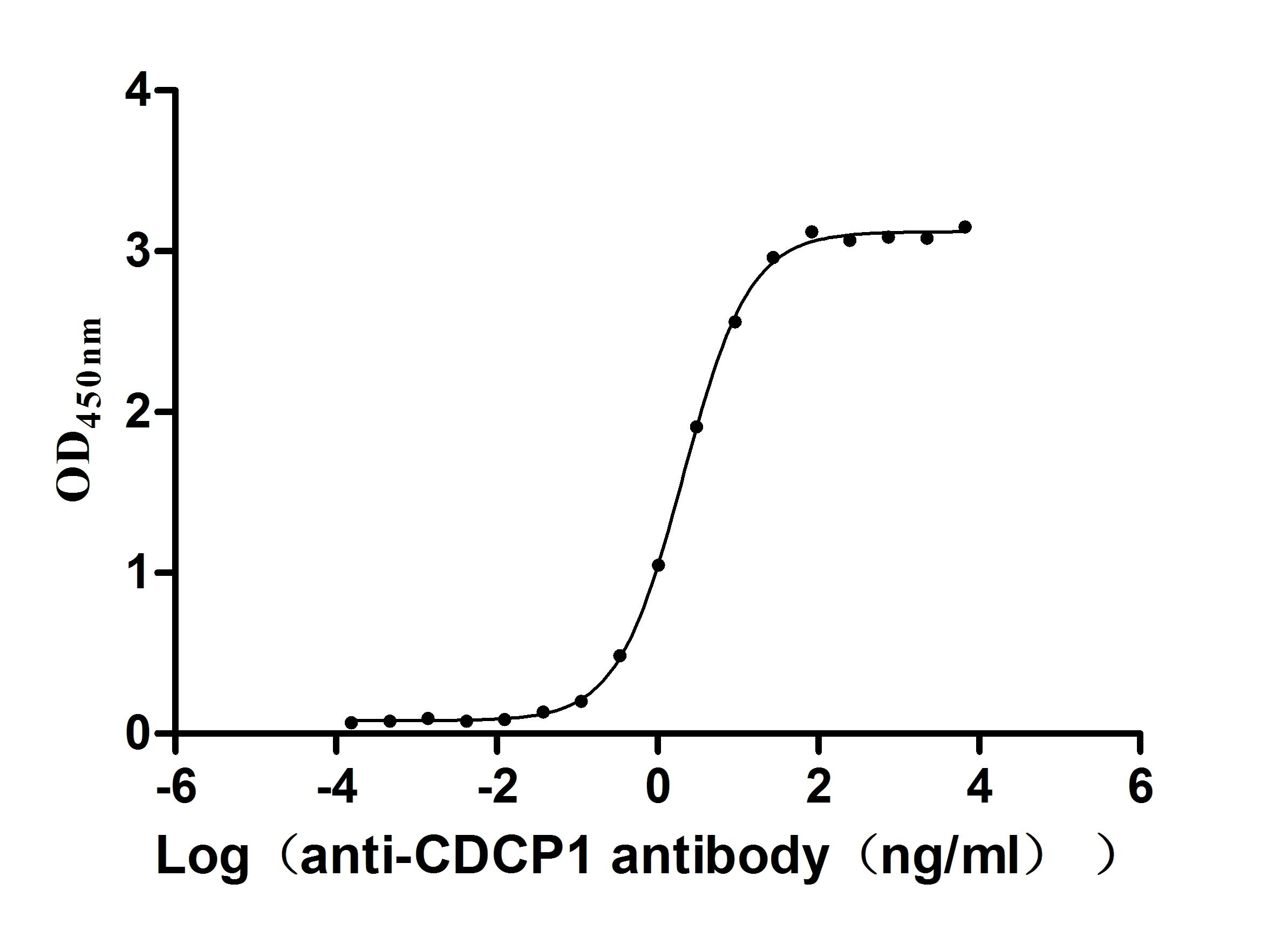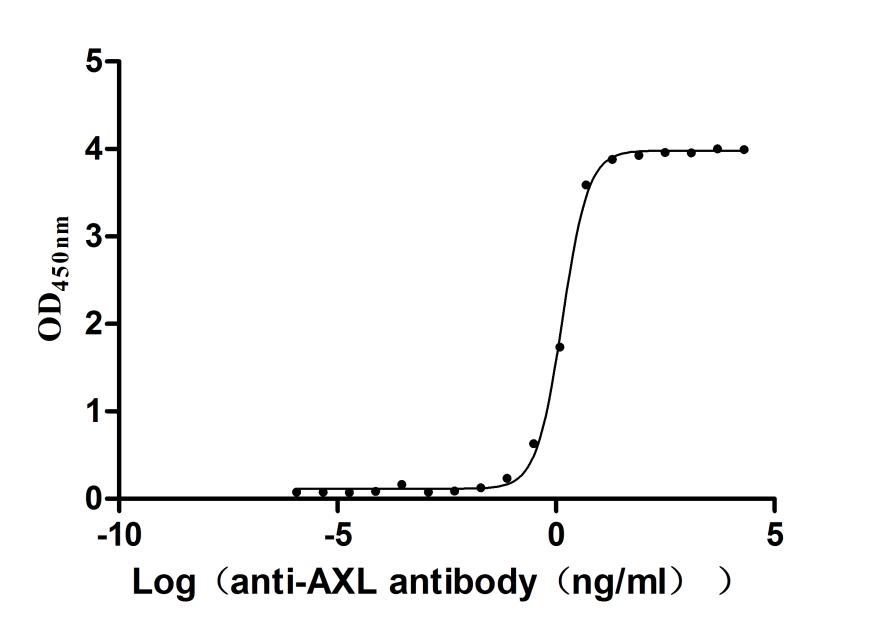Recombinant Rat Tissue-type plasminogen activator (Plat)
-
货号:CSB-YP018120RA
-
规格:
-
来源:Yeast
-
其他:
-
货号:CSB-EP018120RA
-
规格:
-
来源:E.coli
-
其他:
-
货号:CSB-EP018120RA-B
-
规格:
-
来源:E.coli
-
共轭:Avi-tag Biotinylated
E. coli biotin ligase (BirA) is highly specific in covalently attaching biotin to the 15 amino acid AviTag peptide. This recombinant protein was biotinylated in vivo by AviTag-BirA technology, which method is BriA catalyzes amide linkage between the biotin and the specific lysine of the AviTag.
-
其他:
-
货号:CSB-BP018120RA
-
规格:
-
来源:Baculovirus
-
其他:
-
货号:CSB-MP018120RA
-
规格:
-
来源:Mammalian cell
-
其他:
产品详情
-
纯度:>85% (SDS-PAGE)
-
基因名:
-
Uniprot No.:
-
别名:Plat; Tissue-type plasminogen activator; t-PA; t-plasminogen activator; tPA; EC 3.4.21.68) [Cleaved into: Tissue-type plasminogen activator chain A; Tissue-type plasminogen activator chain B]
-
种属:Rattus norvegicus (Rat)
-
蛋白长度:Full Length of Mature Protein
-
表达区域:33-559
-
氨基酸序列SYRATCRD EQTQTTYQQH QSWLRPMLRG NRVEYCRCNS GLAQCHSVPV RSCSEPRCFN GGTCQQALYF SDFVCQCPDG FVGKRCDIDT RATCFEGQGI TYRGTWSTAE NGAECINWNS SALSQKPYSA RRPNAIKLGL GNHNYCRNPD RDVKPWCYVF KAGKYTTEFC STPACPKGPT EDCYVGKGVT YRGTHSFTTS KASCLPWNSM ILIGKTYTAW RANSQALGLG RHNYCRNPDG DAKPWCHVMK DRKLTWEYCD MSPCSTCGLR QYKQPQFRIK GGLFTDITSH PWQAAIFVKN KRSPGERFLC GGVLISSCWV LSAAHCFVER FPPHHLKVVL GRTYRVVPGE EEQTFEIEKY IVHKEFDDDT YDNDIALLQL RSDSSQCAQE SSSVGTACLP DPDVQLPDWT ECELSGYGKH EASSPFFSDR LKEAHVRLYP SSRCTSQHLF NKTITSNMLC AGDTRTGGNQ DVHDACQGDS GGPLVCMIDK RMTLLGIISW GLGCGQKDVP GIYTKVTNYL NWIQDNMKQ
-
蛋白标签:Tag type will be determined during the manufacturing process.
The tag type will be determined during production process. If you have specified tag type, please tell us and we will develop the specified tag preferentially. -
产品提供形式:Lyophilized powder
Note: We will preferentially ship the format that we have in stock, however, if you have any special requirement for the format, please remark your requirement when placing the order, we will prepare according to your demand. -
复溶:We recommend that this vial be briefly centrifuged prior to opening to bring the contents to the bottom. Please reconstitute protein in deionized sterile water to a concentration of 0.1-1.0 mg/mL.We recommend to add 5-50% of glycerol (final concentration) and aliquot for long-term storage at -20℃/-80℃. Our default final concentration of glycerol is 50%. Customers could use it as reference.
-
储存条件:Store at -20°C/-80°C upon receipt, aliquoting is necessary for mutiple use. Avoid repeated freeze-thaw cycles.
-
保质期:The shelf life is related to many factors, storage state, buffer ingredients, storage temperature and the stability of the protein itself.
Generally, the shelf life of liquid form is 6 months at -20°C/-80°C. The shelf life of lyophilized form is 12 months at -20°C/-80°C. -
货期:Delivery time may differ from different purchasing way or location, please kindly consult your local distributors for specific delivery time.Note: All of our proteins are default shipped with normal blue ice packs, if you request to ship with dry ice, please communicate with us in advance and extra fees will be charged.
-
注意事项:Repeated freezing and thawing is not recommended. Store working aliquots at 4°C for up to one week.
-
Datasheet :Please contact us to get it.
相关产品
靶点详情
-
功能:Converts the abundant, but inactive, zymogen plasminogen to plasmin by hydrolyzing a single Arg-Val bond in plasminogen. By controlling plasmin-mediated proteolysis, it plays an important role in tissue remodeling and degradation, in cell migration and many other physiopathological events. During oocyte activation, plays a role in cortical granule reaction in the zona reaction, which contributes to the block to polyspermy.
-
基因功能参考文献:
- t-PA expressed in ECs may help to form IT of the DA via activation of MMP-2 and disruption of IEL PMID: 29304073
- LRP1 assembles unique co-receptor systems to initiate cell signaling in response to tissue-type plasminogen activator and myelin-associated glycoprotein. PMID: 24129569
- Regulation of PAI-1 activity in astrocytes by valproic acid may affect both physiological and pathological processes in the brain by upregulating tPA activity. PMID: 23378038
- Together, because CPAI blocks both proteolytic and nonproteolytic tPA neurotoxicity, it is a promising therapeutics of neonatal HI injury either with or without infection. PMID: 22556277
- Designed t-PA mutants with molecular properties that, in contrast to t-PA, do not induce neurotoxicity. PMID: 23301636
- Tissue plasminogen activator prevents mortality from sulfur mustard analog-induced airway obstruction. PMID: 23258228
- NR2B as a novel proteolytic substrate of tPA, where tPA may directly interact with NR2B subunits leading to a change in pharmacological properties of NR2B-containing NMDA receptors. PMID: 22610100
- mRNA, protein and activity of matrix metalloproteinase (MMP)-2 and MMP-9 and mRNA of tissue plasminogen activator (t-PA) and plasminogen activator inhibitor 1 (PAI-1) were quantified in abdominal aorta (AA) and femoral artery (FA). PMID: 22071631
- The induction of tPA by human marrow stromal cells after traumatic brain injury may be one of the mechanisms involved in promoting functional improvement after traumatic brain injury. PMID: 21355820
- Hydrocortisone up-regulates PAI-1 expression in a tissue-specific manner along with down-regulation of tPA activity in both normal and inflammatory conditions. PMID: 21412817
- PACAP stimulates the release of tPA which promotes cerebellar granule cell survival by a mechanism dependent upon its proteolytic activity. PMID: 21919910
- Massive up-regulation of plasminogen activator inhibitor-1 (PAI-1) in astrocytes during subchronic and chronic inflammatory conditions leads to decreased tPA activity in the later stages of reperfusion injury. PMID: 21193004
- Erigeron breviscapus injection can inhibit the expression of TNF-alpha and PAI-1, and increase the expression of tPA in rats with acute myocardial infarction. PMID: 21355198
- Investigated the brain-protective molecular mechanism of TPA in rats. TPA derivates were intracerebroventricularly administered at 15 min before, and 15, 90, 120 min after middle cerebral artery occlusion. PMID: 20596602
- Annexin A2 combined with low-dose tPA improves thrombolytic therapy in a rat model of focal embolic stroke. PMID: 20068577
- alpha-synuclein up-regulated MMP-9 and down-regulated tPA activity in rat primary astrocytes and microglia in ERK1/2 dependent fashion; suggests a role of alpha-synuclein via regulation of protease systems through modulation of ERK1/2 activity in brain PMID: 20026244
- Both annexin II and TPA were detected on the plasma membrane in a study of the role of proteases in fibronectin matrix remodeling in thyroid epithelial cell monolayer cultures as cells achieve confluence (annexin II)(tissue plasminogen activator) PMID: 11928811
- a chemical sympathectomy study of regulation of the vessel wall release of tissue plasminogen activator by sympathetic nervous system neurons PMID: 12192298
- Reciprocal actions of neural cell adhesion molecule and tissue plasminogen activator via a Ras-dependent mitogen-activated protein kinase signaling pathway in hippocampal neurons. PMID: 12387826
- Enhanced release of enzymatically active tissue plasminogen activator from sympathetic neurons into artery walls and the blood accompanies the changes associated with vascular aging. PMID: 12548713
- Low to moderate doses of rt-PA protect the microvascular basal lamina lamina during experimental focal cerebral ischemia, whereas high doses of rt-PA have the opposite effect, probably due to increased coactivation of MMP-2 and MMP-9. PMID: 12783121
- after transient focal cerebral ischemia, there are time dependent changes in tPA expression PMID: 14512838
- The 600 bp of the tPA promoter upstream of the transcription start site conveys cell specificity to tPA expression and an NF1 site within this region acts as a repressor. PMID: 15044208
- tPA activity is rapidly increased in hippocampal neurons after glutamate stimulation, corresponding to an increase in translational activation of mRNA present at the time of stimulation. PMID: 15496678
- These results suggest the importance of the t-PA/plasmin cascade during the early pathological stages of delayed neuronal death in the hippocampus following transient forebrain ischemia. PMID: 15882815
- Sympathetic nerves are the primary source of stress-induced release of t-PA into and from the densely innervated resistance arteries and arterioles. PMID: 16019605
- tPA upregulates brain MMP-9 levels in stroke in vivo PMID: 16051896
- tPA is localized in dendrites and terminals of AVP-expressing neurons; tPA is released in an activity-dependent manner, suggesting that matrix-degrading proteases are candidate molecules to be concerned with the structural plasticity in the HNS. PMID: 16150423
- tPA acts as a cytokine that binds to the cell membrane receptor LRP-1, induces its tyrosine phosphorylation, and triggers intracellular signal transduction to induce MMP9 gene expression PMID: 16303771
- TPA resides in dense-core granules that traffic to postsynaptic dendritic spines and that can remain there for extended periods. Depolarization by potassium elicits exocytotic release of tPA from DCGs in spines that is dependent on calcium signaling. PMID: 16555239
- Astrocyte-derived tPA and the proteolytic activity in the dorsal horn may be one of the essential factors involved in pain following root injury. PMID: 17299772
- Sertoli cells isolated from rat testes at various ages in vitro secreted tPA in an age-dependent manner. PMID: 17992606
- tPA induces LRP-1 tyrosine phosphorylation, which in turn facilitates the LRP-1-mediated recruitment of beta1 integrin and downstream ILK signaling, thereby leading to myofibroblast activation. PMID: 18037995
- The critical period of visual cortical plasticity, which occurs in early postnatal life, correlates well with tPA expression in the rat visual cortex. PMID: 18523654
- function of the tPA during diapedesis of monocytes through brain endothelial barrier; monocytes induce the release of tPA by brain endothelial cells; tPA and ERK1/2 control the breakdown of the tight junction protein occludin. PMID: 18714030
- The increase of tPA in the acute phase after hypoxic-ischemic brain damage may be helpful to clot dissolving, but it induces neuronal apoptosis and aggravates brain injury. PMID: 18947492
- FSH-induced ERK1/2 and p38 MAPK activation is capable of regulating tPA production in cultured primary granulosa cells. PMID: 18982462
- Our results demonstrated the involvement of tPA in the secondary pathogenesis after spinal cord injury as well as the therapeutic potential of hUCB. PMID: 19152029
- t-PA and PAI-1 mRNA were decreased after sympathectomy and remained unchanged after AT1 receptors blockade PMID: 19403340
- protein aggregates formed during neuronal injury provide a macromolecular, nonfibrin cofactor that promotes tPA-mediated plasmin formation and subsequent cell breakdown PMID: 19584397
显示更多
收起更多
-
亚细胞定位:Secreted, extracellular space.
-
蛋白家族:Peptidase S1 family
-
数据库链接:
KEGG: rno:25692
STRING: 10116.ENSRNOP00000025764
UniGene: Rn.107102
Most popular with customers
-
Recombinant Human Somatostatin receptor type 2 (SSTR2)-VLPs (Active)
Express system: Mammalian cell
Species: Homo sapiens (Human)
-
Recombinant Human Early activation antigen CD69 (CD69), partial (Active)
Express system: Mammalian cell
Species: Homo sapiens (Human)
-
Recombinant Human Killer cell immunoglobulin-like receptor 3DL2 (KIR3DL2), partial (Active)
Express system: Mammalian cell
Species: Homo sapiens (Human)
-
Recombinant Macaca fascicularis CUB domain containing protein 1 (CDCP1), partial (Active)
Express system: Mammalian cell
Species: Macaca fascicularis (Crab-eating macaque) (Cynomolgus monkey)
-
Recombinant Human C-C chemokine receptor type 6(CCR6)-VLPs (Active)
Express system: Mammalian cell
Species: Homo sapiens (Human)
-
Recombinant Human Tyrosine-protein kinase receptor UFO(AXL),partial (Active)
Express system: Mammalian cell
Species: Homo sapiens (Human)


















